Yakuza
Yakuza (Japanese: ヤクザ, IPA: [jaꜜkɯza]), also known as gokudō (極道, "the extreme path", IPA: [gokɯꜜdoː]), are members of transnational organized crime syndicates originating in Japan. The Japanese police, and media by request of the police, call them bōryokudan (暴力団, "violent groups", IPA: [boːɾʲokɯꜜdaɴ]), while the yakuza call themselves ninkyō dantai (任侠団体/仁侠団体, "chivalrous organizations", IPA: [ɲiŋkʲoː dantai]). The English equivalent for the term yakuza is gangster, meaning an individual involved in a Mafia-like criminal organization.[2] The yakuza are notorious for their strict codes of conduct, their organized fiefdom nature, and several unconventional ritual practices such as yubitsume, or amputation of the left little finger.[3] Members are often described as males, wearing "sharp suits" with heavily tattooed bodies and slicked hair.[4] This group is still regarded as being among "the most sophisticated and wealthiest criminal organizations."[5]
| Founded | 17th century (presumed to have originated from the Kabukimono) |
|---|---|
| Membership | 28,000 members[1] |
| Activities | Varied, including illegitimate businesses, an array of criminal and non criminal activities. |
| Notable members | Principal clans: |
At their height, the yakuza maintained a large presence in the Japanese media and operated internationally. At their peak in the early 1960s, police estimated that the yakuza had a membership of more than 200,000.[6] However, this number has drastically dropped, a decline attributed to changing market opportunities and several legal and social developments in Japan which discourage the growth of yakuza membership.[7] The yakuza still regularly engage in an array of criminal activities, and many Japanese citizens remain fearful of the threat these individuals pose to their safety.[8] However, there remains no strict prohibition on yakuza membership in Japan today, although much legislation has been passed by the Japanese government aimed at increasing liability for criminal activities and impeding revenue.[8]
Etymology
The name yakuza originates from the traditional Japanese card game Oicho-Kabu, a game in which the goal is to draw three cards adding up to a score of 9. If the sum of the cards exceeds 10, its second digit is used as the score instead, and if the sum is exactly 10, the score is 1. If the three cards drawn are 8-9-3 (pronounced ya-ku-sa in Japanese), the sum is 20 and therefore the score is zero, making it the worst possible hand that can be drawn.[9]
Origins
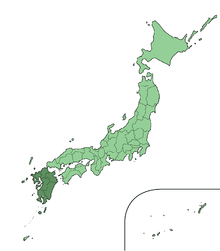
Despite uncertainty about the single origin of yakuza organizations, most modern yakuza derive from two social classifications which emerged in the mid-Edo period (1603–1868): tekiya, those who primarily peddled illicit, stolen, or shoddy goods; and bakuto, those who were involved in or participated in gambling.[10]
Tekiya (peddlers) ranked as one of the lowest social groups during the Edo period. As they began to form organizations of their own, they took over some administrative duties relating to commerce, such as stall allocation and protection of their commercial activities.[11] During Shinto festivals, these peddlers opened stalls and some members were hired to act as security. Each peddler paid rent in exchange for a stall assignment and protection during the fair.
The tekiya were a highly structured and hierarchical group with the oyabun (boss) at the top and kobun (gang members) at the bottom.[12] This hierarchy resembles a structure similar to the family - the oyabun was often regarded as a surrogate father, and the kobun as surrogate children.[12] During the Edo period, the government formally recognized the tekiya. At this time, the oyabun were appointed as supervisors and granted near-samurai status, meaning they were allowed the dignity of a surname and two swords.[13]
Bakuto (gamblers) had a much lower social standing even than traders, as gambling was illegal. Many small gambling houses cropped up in abandoned temples or shrines at the edges of towns and villages all over Japan. Most of these gambling houses ran loan-sharking businesses for clients, and they usually maintained their own security personnel. Society at large regarded the gambling houses themselves, as well as the bakuto, with disdain. Much of the undesirable image of the Yakuza originates from bakuto; this includes the name Yakuza itself.
Because of the economic situation during the mid-period and the predominance of the merchant class, developing Yakuza groups were composed of misfits and delinquents who had joined or formed Yakuza groups to extort customers in local markets by selling fake or shoddy goods.
The roots of the Yakuza survive today in initiation ceremonies, which incorporate tekiya or bakuto rituals. Although the modern Yakuza has diversified, some gangs still identify with one group or the other; for example, a gang whose primary source of income is illegal gambling may refer to themselves as bakuto.
Organization and activities
Structure
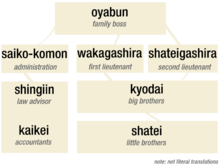
During the formation of the Yakuza, they adopted the traditional Japanese hierarchical structure of oyabun-kobun where kobun (子分; lit. foster child) owe their allegiance to the oyabun (親分, lit. foster parent). In a much later period, the code of jingi (仁義, justice and duty) was developed where loyalty and respect are a way of life.
The oyabun-kobun relationship is formalized by ceremonial sharing of sake from a single cup. This ritual is not exclusive to the Yakuza—it is also commonly performed in traditional Japanese Shinto weddings, and may have been a part of sworn brotherhood relationships.[14]
During the World War II period in Japan, the more traditional tekiya/bakuto form of organization declined as the entire population was mobilised to participate in the war effort and society came under strict military government. However, after the war, the Yakuza adapted again.
Prospective Yakuza come from all walks of life. The most romantic tales tell how Yakuza accept sons who have been abandoned or exiled by their parents. Many Yakuza start out in junior high school or high school as common street thugs or members of bōsōzoku gangs. Perhaps because of its lower socio-economic status, numerous Yakuza members come from Burakumin and ethnic Korean backgrounds.
Yakuza groups are headed by an oyabun or kumichō (組長, family head) who gives orders to his subordinates, the kobun. In this respect, the organization is a variation of the traditional Japanese senpai-kōhai (senior-junior) model. Members of Yakuza gangs cut their family ties and transfer their loyalty to the gang boss. They refer to each other as family members - fathers and elder and younger brothers. The Yakuza is populated almost entirely by men and the very few women who are acknowledged are the wives of bosses, who are referred to by the title ane-san (姐さん, older sister). When the 3rd Yamaguchi-gumi boss (Kazuo Taoka) died in the early 1980s, his wife (Fumiko) took over as boss of Yamaguchi-gumi, albeit for a short time.
Yakuza have a complex organizational structure. There is an overall boss of the syndicate, the kumicho, and directly beneath him are the saiko komon (senior advisor) and so-honbucho (headquarters chief). The second in the chain of command is the wakagashira, who governs several gangs in a region with the help of a fuku-honbucho who is himself responsible for several gangs. The regional gangs themselves are governed by their local boss, the shateigashira.[15]
Each member's connection is ranked by the hierarchy of sakazuki (sake sharing). Kumicho are at the top, and control various saikō-komon (最高顧問, senior advisors). The saikō-komon control their own turfs in different areas or cities. They have their own underlings, including other underbosses, advisors, accountants and enforcers.
Those who have received sake from oyabun are part of the immediate family and ranked in terms of elder or younger brothers. However, each kobun, in turn, can offer sakazuki as oyabun to his underling to form an affiliated organisation, which might in turn form lower ranked organizations. In the Yamaguchi-gumi, which controls some 2,500 businesses and 500 Yakuza groups, there are fifth rank subsidiary organizations.
Rituals
_-_Tattooed_japanese_men_-_ca._1870.jpg)
Yubitsume, or the cutting off of one's finger, is a form of penance or apology. Upon a first offense, the transgressor must cut off the tip of his left little finger and give the severed portion to his boss. Sometimes an underboss may do this in penance to the oyabun if he wants to spare a member of his own gang from further retaliation. This practice has started to wane amongst the younger members, due to it being an easy identifier for police.[16]
Its origin stems from the traditional way of holding a Japanese sword. The bottom three fingers of each hand are used to grip the sword tightly, with the thumb and index fingers slightly loose. The removal of digits starting with the little finger moving up the hand to the index finger progressively weakens a person's sword grip.
The idea is that a person with a weak sword grip then has to rely more on the group for protection—reducing individual action. In recent years, prosthetic fingertips have been developed to disguise this distinctive appearance.[14]
Many Yakuza have full-body tattoos (including their genitalia). These tattoos, known as irezumi in Japan, are still often "hand-poked", that is, the ink is inserted beneath the skin using non-electrical, hand-made and handheld tools with needles of sharpened bamboo or steel. The procedure is expensive, painful, and can take years to complete.[17]
When Yakuza members play Oicho-Kabu cards with each other, they often remove their shirts or open them up and drape them around their waists. This enables them to display their full-body tattoos to each other. This is one of the few times that Yakuza members display their tattoos to others, as they normally keep them concealed in public with long-sleeved and high-necked shirts. When new members join, they are often required to remove their trousers as well and reveal any lower body tattoos.
Syndicates
Four largest syndicates
Although Yakuza membership has declined since the implementation of the Anti-Boryokudan Act in 1992, there are still approximately 28,200 active Yakuza members in Japan as of 2019.[18] The Yakuza does not consist of just one group, rather there are many different syndicate groups that together form one of the largest organized crime groups in the world.[19]
| Principal families | Description | Mon (crest) |
|---|---|---|
| Yamaguchi-gumi (山口組, Yamaguchi-gumi) | The Yamaguchi-gumi is the largest Yakuza family, accounting for 30% of all Yakuza in Japan, with more than 8,900 members.[20] From its headquarters in Kobe, it directs criminal activities throughout Japan. It is also involved in operations in Asia and the United States. Shinobu Tsukasa, also known as Kenichi Shinoda, is the Yamaguchi-gumi's current oyabun. He follows an expansionist policy, and has increased operations in Tokyo (which has not traditionally been the territory of the Yamaguchi-gumi.)
The Yamaguchi family is successful to the point where its name has become synonymous with Japanese organized crime in many parts of Asia outside Japan. Many Chinese or Korean persons who do not know the name "Yakuza" would know the name "Yamaguchi-gumi", which is frequently portrayed in gangster films. |
 "Yamabishi" (山菱) |
| Sumiyoshi-kai (住吉会) | The Sumiyoshi-kai is the second largest Yakuza family, with an estimated 4,500 members. Sumiyoshi-kai is a confederation of smaller Yakuza groups. Its current head (会長 kai-cho) is Isao Seki. Structurally, Sumiyoshi-kai differs from its principal rival, the Yamaguchi-gumi, in that it functions like a federation. The chain of command is more relaxed, and its leadership is distributed among several other members. | 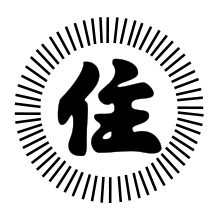 |
| Inagawa-kai (稲川会) | The Inagawa-kai is the third largest Yakuza family in Japan, with roughly 3,400 members. It is based in the Tokyo-Yokohama area and was one of the first Yakuza families to expand its operations outside of Japan. | 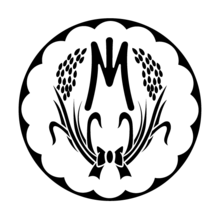 |
| Aizukotetsu-kai (六代目会津小鉄会, Rokudaime Aizukotetsu-kai) | The Aizukotetsu-kai is the fourth largest Yakuza family in Japan. Rather than a stand-alone gang, the Aizukotetsu-kai is a federation of approximately 100 of Kyoto's various Yakuza groups. Its name comes from the Aizu region, "Kotetsu", a type of Japanese sword. Its main base is in Kyoto. |  |
Designated bōryokudan
A designated boryokudan (指定暴力団, Shitei Bōryokudan)[21] is a "particularly harmful" Yakuza group[22] registered by the Prefectural Public Safety Commissions under the Organized Crime Countermeasures Law (暴力団対策法, Bōryokudan Taisaku Hō) enacted in 1991.[23]
Under the Organized Crime Countermeasures Law, the Prefectural Public Safety Commissions have registered 21 syndicates as the designated boryokudan groups.[24] Fukuoka Prefecture has the largest number of designated boryokudan groups among all of the prefectures, at 5; the Kudo-kai, the Taishu-kai, the Fukuhaku-kai, the Dojin-kai and the Namikawa-kai.[25]
Designated boryokudan groups are usually large organizations (mostly formed before World War II, some before the Meiji Restoration of the 19th century); however, there are some exceptions such as the Namikawa-kai, which, with its blatant armed conflicts with the Dojin-kai, was registered only two years after its formation.
Current activities
Japan
Yakuza are regarded as semi-legitimate organizations. For example, immediately after the Kobe earthquake, the Yamaguchi-gumi, whose headquarters are in Kobe, mobilized itself to provide disaster relief services (including the use of a helicopter), and this was widely reported by the media as a contrast to the much slower response by the Japanese government.[26][27] The Yakuza repeated their aid after the 2011 Tōhoku earthquake and tsunami, with groups opening their offices to refugees and sending dozens of trucks with supplies to affected areas.[28] For this reason, many Yakuza regard their income and hustle (shinogi) as a collection of a feudal tax.
The yakuza and its affiliated gangs control drug trafficking in Japan, especially methamphetamine.[29] While many Yakuza syndicates, notably the Yamaguchi-gumi, officially forbid their members from engaging in drug trafficking, some other Yakuza syndicates, notably the Dojin-kai, are heavily involved in it.
Some Yakuza groups are known to deal extensively in human trafficking.[30] The Philippines, for instance, is a source of young women. Yakuza trick girls from impoverished villages into coming to Japan, where they are promised respectable jobs with good wages. Instead, they are forced into becoming sex workers and strippers.[31]
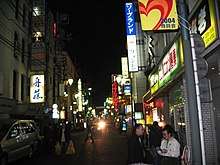
Yakuza frequently engage in a unique form of Japanese extortion known as sōkaiya. In essence, this is a specialized form of protection racket. Instead of harassing small businesses, the Yakuza harass a stockholders' meeting of a larger corporation. They simply scare the ordinary stockholder with the presence of Yakuza operatives, who obtain the right to attend the meeting by making a small purchase of stock.
Yakuza also have ties to the Japanese realty market and banking, through jiageya. Jiageya specialize in inducing holders of small real estate to sell their property so that estate companies can carry out much larger development plans. Japan's bubble economy of the 1980s is often blamed on real estate speculation by banking subsidiaries. After the collapse of the Japanese property bubble, a manager of a major bank in Nagoya was assassinated, and much speculation ensued about the banking industry's indirect connection to the Japanese underworld.[32]
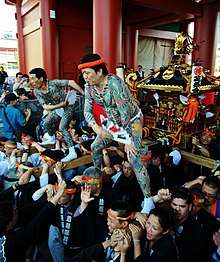
Yakuza have been known to make large investments in legitimate, mainstream companies. In 1989, Susumu Ishii, the Oyabun of the Inagawa-kai (a well known Yakuza group) bought US$255 million worth of Tokyo Kyuko Electric Railway's stock.[33] Japan's Securities and Exchange Surveillance Commission has knowledge of more than 50 listed companies with ties to organized crime, and in March 2008, the Osaka Securities Exchange decided to review all listed companies and expel those with Yakuza ties.[34]
As a matter of principle, theft is not recognised as a legitimate activity of Yakuza. This is in line with the idea that their activities are semi-open; theft by definition would be a covert activity. More importantly, such an act would be considered a trespass by the community. Also, Yakuza usually do not conduct the actual business operation by themselves. Core business activities such as merchandising, loan sharking or management of gambling houses are typically managed by non-Yakuza members who pay protection fees for their activities.
There is much evidence of Yakuza involvement in international crime. There are many tattooed Yakuza members imprisoned in various Asian prisons for such crimes as drug trafficking and arms smuggling. In 1997, one verified Yakuza member was caught smuggling 4 kilograms (8.82 pounds) of heroin into Canada.
Because of their history as a legitimate feudal organization and their connection to the Japanese political system through the uyoku dantai (extreme right-wing political groups), Yakuza are somewhat a part of the Japanese establishment, with six fan magazines reporting on their activities.[35] Yakuza involvement in politics functions similarly to that of a lobbying group, with them backing those who share in their opinions or beliefs.[36] One study found that 1 in 10 adults under the age of 40 believed that the Yakuza should be allowed to exist.[28] In the 1980s in Fukuoka, a Yakuza war spiraled out of control and civilians were hurt. It was a large conflict between the Yamaguchi-gumi and Dojin-kai, called the Yama-Michi War. The police stepped in and forced the Yakuza bosses on both sides to declare a truce in public.
At various times, people in Japanese cities have launched anti-Yakuza campaigns with mixed and varied success. In March 1995, the Japanese government passed the Act for Prevention of Unlawful Activities by Criminal Gang Members, which made traditional racketeering much more difficult. Beginning in 2009, led by agency chief Takaharu Ando, Japanese police began to crack down on the gangs. Kodo-kai chief Kiyoshi Takayama was arrested in late 2010. In December 2010, police arrested Yamaguchi-gumi's alleged number three leader, Tadashi Irie. According to the media, encouraged by tougher anti-Yakuza laws and legislation, local governments and construction companies have begun to shun or ban Yakuza activities or involvement in their communities or construction projects.[37] The police are handicapped, however, by Japan's lack of an equivalent to plea bargaining, witness protection, or the United States' Racketeer Influenced and Corrupt Organizations Act.[34] Laws were enacted in Osaka and Tokyo in 2010 and 2011 to try to combat Yakuza influence by making it illegal for any business to do business with the Yakuza.[38][39]
Yakuza's aid in Tōhoku catastrophe
Following the Tōhoku earthquake and tsunami on 11 March 2011, the Yakuza sent hundreds of trucks filled with food, water, blankets, and sanitary accessories to aid the people in the affected areas of the natural disaster. CNN México said that although the Yakuza operates through extortion and other violent methods, they "[moved] swiftly and quietly to provide aid to those most in need."[40] Such actions by the Yakuza are a result of their knowing of what it is like to "fend for yourself," without any government aid or community support, because they are also considered "outcasts" and "dropouts from society".[40] In addition, the Yakuza's code of honor (ninkyo) reportedly values justice and duty above anything else, and forbids allowing others to suffer.[41]
United States
Yakuza activity in the United States is mostly restricted to Hawaii, but they have made their presence known in other parts of the country, especially in Los Angeles and the San Francisco Bay Area, as well as Seattle, Las Vegas, Arizona, Virginia, Chicago, and New York City.[42][43] The Yakuza are said to use Hawaii as a midway station between Japan and mainland America, smuggling methamphetamine into the country and smuggling firearms back to Japan. They easily fit into the local population, since many tourists from Japan and other Asian countries visit the islands on a regular basis, and there is a large population of residents who are of full or partial Japanese descent. They also work with local gangs, funneling Japanese tourists to gambling parlors and brothels.[42]
In California, the Yakuza have made alliances with local Korean gangs as well as Chinese triads. They allied with Vietnamese gangs to use them as muscle, as they had potential to become extremely violent as needed. The Yakuza saw their potential following the constant Vietnamese cafe shoot-outs and home invasion burglaries throughout the 1980s and early 1990s. In New York City, they appear to collect finder's fees from Russian, Irish and Italian gang members and businessmen for guiding Japanese tourists to gambling establishments, both legal and illegal.[42]
Handguns manufactured in the US account for a large share (33%) of handguns seized in Japan, followed by China (16%) and the Philippines (10%). In 1990, a Smith & Wesson .38 caliber revolver that cost $275 in the US could sell for up to $4,000 in Tokyo. By 1997 it would sell for only $500 due to the proliferation of guns in Japan during the 1990s.[43]
The FBI suspects that the Yakuza use various operations to launder money in the U.S.[34]
In 2001, the FBI's representative in Tokyo arranged for Tadamasa Goto, the head of the group Goto-gumi, to receive a liver transplant at the UCLA Medical Center in the United States, in return for information of Yamaguchi-gumi operations in the US. This was done without prior consultation of the NPA. The journalist who uncovered the deal received threats by Goto and was given police protection in the US and in Japan.[34]
Southeast Asia
The yakuza are engaged in Southeast Asia since the 1960s, they are working there to develop sex tourism and drug trafficking.[44] This is the area where they are still the most active today.
They are thus present in South Korea, China, Taiwan, Thailand, the Philippines, Vietnam and in the Pacific Islands (especially Hawaii)[45]
North Korea
In 2009, Yakuza member Yoshiaki Sawada was released from North Korea after spending five years in the country for attempting to bribe a North Korean official and smuggle drugs.[46]
Constituent members
According to a 2006 speech by Mitsuhiro Suganuma, a former officer of the Public Security Intelligence Agency, around 60 percent of Yakuza members come from burakumin, the descendants of a feudal outcast class and approximately 30 percent of them are Japanese-born Koreans, and only 10 percent are from non-burakumin Japanese and Chinese ethnic groups.[47][48]
Burakumin
The burakumin are a group that is socially discriminated against in Japanese society, whose recorded history goes back to the Heian period in the 11th century. The burakumin are descendants of outcast communities of the pre-modern, especially the feudal era, mainly those with occupations considered tainted with death or ritual impurity, such as butchers, executioners, undertakers, or leather workers. They traditionally lived in their own secluded hamlets.
According to David E. Kaplan and Alec Dubro, burakumin account for about 70% of the members of Yamaguchi-gumi, the largest Yakuza syndicate in Japan.[49]
Ethnic Koreans
While ethnic Koreans make up only 0.5% of the Japanese population, they are a prominent part of Yakuza because they suffer severe discrimination in Japanese society alongside the burakumin.[50][51] In the early 1990s, 18 of 90 top bosses of Inagawa-kai were ethnic Koreans. The Japanese National Police Agency suggested Koreans composed 10% of the Yakuza proper and 70% of burakumin in the Yamaguchi-gumi.[50] Some of the representatives of the designated Bōryokudan are also Koreans.[52] The Korean significance had been an untouchable taboo in Japan and one of the reasons that the Japanese version of Kaplan and Dubro's Yakuza (1986) had not been published until 1991 with the deletion of Korean-related descriptions of the Yamaguchi-gumi.[53]
Japanese-born people of recent Korean ancestry are considered resident aliens because of their nationality and are often shunned in legitimate trades, and are therefore embraced by the Yakuza precisely because they fit the group's "outsider" image.[54][16] Notable Yakuza members of Korean ancestry include Hisayuki Machii the founder of the Tosei-kai, Jiro Yanagawa the founder of the Yanagawa-gumi, Hirofumi Hashimoto the founder of the Kyokushinrengo-kai, Yoshinori Oda the founder of the Kizuna-kai, Tokutaro Takayama the head of the 4th-generation Aizukotetsu-kai, Jiro Kiyota the head of the 5th-generation Inagawa-kai, Makoto Suehiro the head of the 7th-generation Goda-ikka, Shinichi Matsuyama the head of the 5th-generation Kyokuto-kai, Kuniyasu Makino the head of the 5th-generation Matsuba-kai, Akira Takamura the head of the 5th-generation Soai-kai, Chojiro Murakami the head of the 1st-generation Kyushu Seido-kai, Masahiro Namikawa the head of the 2nd-generation Kyushu Seido-kai & founder of the Namikawa-kai, the head of the 3rd / 4th Fukuhaku-kai, and the head of the 6th / 7th Sakaume-gumi.
Indirect enforcement
Since 2011, regulations that made business with members illegal as well as enactments of Yakuza exclusion ordinances led to the group's membership decline from its 21st century peak. Methods include that which brought down Al Capone: checking the organization's finances. The Financial Services Agency ordered Mizuho Financial Group, Inc. to improve compliance and that its top executives report by 28 October 2013 what they knew and when about a consumer-credit affiliate found making loans to crime groups. This adds pressure to the group from the U.S. as well where an executive order in 2011 required financial institutions to freeze Yakuza assets. As of 2013, the U.S. Treasury Department has frozen about US$55,000 of Yakuza holdings, including two Japan-issued American Express cards.[55]
Legacy
Yakuza in society
The Yakuza have had mixed relations with Japanese society. Despite their pariah status, some of their actions may be perceived to have positive effects on society. For example, they stop other criminal organisations acting in their areas of operation. They have been known to provide relief in times of disaster. These actions have at times painted Yakuza in a fairly positive light within Japan. However, gang-wars, and the use of violence as a tool have caused their approval to fall with the general public. See Murder of Junko Furuta.[56]
Film
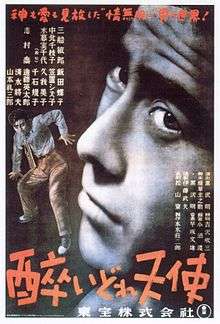
The Yakuza have been in media and culture in many different fashions. Creating its own genre of movies within Japan's film industry, the portrayal of the Yakuza mainly manifests in one of two archetypes; they are portrayed as either honorable and respectable men or as criminals who use fear and violence as their means of operation.[57] Movies like Battles Without Honor and Humanity and Dead or Alive portray some of the members as violent criminals, with the focus being on the violence, while other movies focus more on the "business" side of the Yakuza.
The 1992 film Minbo, a satirical view of Yakuza activities, resulted in retaliation against the director, as real-life Yakuza gangsters attacked the director Juzo Itami shortly after the release of the film. [58]
Yakuza films have also been popular in the Western market with films such as the 1975 film The Yakuza, the 1989 film Black Rain, the 2005 film Into the Sun, and the 2018 film, The Outsider. These are some of the most striking Yakuza movies.
Television
The Yakuza make an appearance outside 742 Evergreen Terrace in an episode ofThe Simpsons, "The Twisted World of Marge Simpson". Marge's fast food rivals ask the Yakuza to help shut down Marge's pretzel franchise, where they fight a Mafia family led by Fat Tony.
The Yakuza play a very important role in the Hawaii Five-0 remake. Lead character Kono Kalakaua's husband Adam Noshimuri was the former head of the Yakuza who took over after his father Hiro Noshimuri died. Adam's brother Michael Noshimuri was also part of the Yakuza.
The Yakuza are also the basis for the 2019 BBC TV Series Giri/Haji, which features a character whose life is put in danger after he comes under suspicion for a murder tied to the Yakuza.
The Yakuza were also a prominent force in the Amazon Prime series The Man In The High Castle. They appeared in all four seasons of the series.
Video games
The video game series Yakuza, launched in 2005, portrays the actions of several different ranking members of the Yakuza, as well as criminal associates such as dirty cops and loan sharks. The series addresses some of the same themes as the Yakuza genre of film does, like violence, honor, politics of the syndicates, and the social status of the Yakuza in Japan. The series has been successful, spawning sequels, spin-offs, a live action movie, and a web TV series.
Grand Theft Auto III features a Yakuza clan that assists the protagonist in the second and third act after they cut their ties with the Mafia. The Yakuza derive most of their income from a casino, Kenji's, and are currently fighting to keep other gangs from peddling drugs in their territory while seeking to protect their activities from police interference. Towards the end of the third act, the player assassinates the leader of the clan, and the other members are later executed by Colombian gangsters.
Hitman 2: Silent Assassin features a mission set in Japan that sees Agent 47 assassinating the son of a wealthy arms dealer during his dinner meeting with a Yakuza boss at his private estate. A mission in a later game, Hitman, set at a secluded mountaintop hospital, features a notorious Yakuza lawyer and fixer as one of two targets to be assassinated.
Manga, anime and drama
- Gokusen: manga (2000), drama (2002, 2005 and 2008) and anime (2004). The heiress of a clan becomes a teacher in a difficult high school, and is assigned a class of delinquents, the 3-D. She will teach them mathematics, while gradually getting involved in several other levels, going so far as to get her students out of a bad situation by sometimes using her skills as heir to the clan.
- My Boss, My Hero: Film stock (2001), drama (2002). A young gang leader, who seems to be too stupid to do his job, misses a big deal because he can't count correctly, and on the other hand is practically illiterate. In order to access the succession of the clan, his father then forces him to return to high school, to obtain his diploma. He must not reveal his membership in the yakuza , under penalty of being immediately excluded.
- Twittering Birds Never Fly: manga of the shōnen-ai genre(2011-?). Yashiro, a totally depraved masochist, boss of a yakuza clan and the Shinsei finance company, hires Chikara Dômeki, a secretive and not very talkative man, as his bodyguard. While Yashiro would like to take advantage of Dômeki's body, the latter is helpless.[59]
- Like the Beast: manga, yaoi (2008). Tomoharu Ueda, a police officer in a small local post, meets Aki Gotôda, son of the leader of a Yakuza clan, in pursuit of an underwear thief. The next morning, Aki shows up at his house to thank him for his help and finds himself making a declaration of love for him. Taken aback, Ueda replies that it is better that they get to know each other, but that's without counting Aki's stubbornness, ready to do anything to achieve his ends.
Several manga by Ryoichi Ikegami are located in the middle of the Japanese underworld:
- Crying Freeman (1986).
- Sanctuary (1990): Hôjô and Asami, childhood friends, have only one goal: to give the Japanese back a taste for life, and to shake up the country. For this, they decide to climb the ladder of power, one in the light , as a politician, the other in the shadows , as yakuza.
- Strain (1996).
- Heat (1999): Tatsumi Karasawa is the owner of a club in Tokyo who plans to expand his business. He gives a hard time not only to the police, but also to the yakuza , of which he manages, however, to rally a certain number at his side.
See also
- 893239 or Yakuza-Nijusan-Ku
- Bōsōzoku
- Chimpira, low ranking Yakuza
- Crime in Japan
- Criminal tattoo
- Gopnik
- Irezumi
- Kkangpae (Korean mafia)
- List of criminal enterprises, gangs and syndicates
- Organized crime
- Punch perm
- Russian mafia
- Sicilian Mafia
- American Mafia
- Triads
- Yakuza exclusion ordinances
References
- https://www.japantimes.co.jp/news/2020/04/03/national/crime-legal/yakuza-group-membership-falls-15th-straight-year/
- Britannica Academic, s.v. "Yakuza," accessed 30 September 2018, https://academic.eb.com/levels/collegiate/article/yakuza/77739.
- Bosmia, Anand, Griessenauer, Christoph, AND Tubbs, R.. " Yubitsume: ritualistic self-amputation of proximal digits Among the yakuza" Journal of Injury and Violence Research [Online], Volume 6 Number 2 (9 October 2013)
- "Feeling the heat; The yakuza." The Economist, 28 February 2009, 55(EU). Academic OneFile (accessed 30 September 2018). http://link.galegroup.com/apps/doc/A194486438/AONE?u=lond95336&sid=AONE&xid=b854515e.
- Reilly, Edward F., Jr. "Criminalizing Yakuza membership: a comparative study of the anti-boryokudan law." Washington University Global Studies Law Review 13, no. 4 (2014): 801+. Academic OneFile (accessed 30 September 2018). http://link.galegroup.com/apps/doc/A418089219/AONE?u=lond95336&sid=AONE&xid=e68cfefe.
- "Police of Japan 2017" http://www.npa.go.jp/english/kokusai/pdf/Police_of_Japan_2017_full_text.pdf/.
- Hill, Peter. 2004. "The Changing Face of the Yakuza." Global Crime 6 (1): 97-116. doi:10.1080/1744057042000297007.
- Shikata, Ko. 2006. Yakuza - organized crime in japan. Journal of Money Laundering Control 9, (4): 416-421, http://search.proquest.com/docview/235850419 (accessed 30 September 2018).
- "Yakuza" definition. Kotobank (in Japanese)
- David E. Kaplan and Alec Dubro, Yakuza: The Explosive Account of Japan's Criminal Underworld (Reading, Mass: Addison-Wesley, 1986), 18-21.
- Joy, Alicia. "A Brief History Of The Yakuza Organization". Culture Trip. Last modified 31 October 2016. https://theculturetrip.com/asia/japan/articles/a-brief-history-of-the-yakuza-organization/.
- Raz, Jacob. "Insider Outsider: The Way of the Yakuza." Kyoto Journal. Last modified 17 April 2011. https://kyotojournal.org/society/insider-outsider/.
- David E. Kaplan and Alec Dubro, Yakuza: The Explosive Account of Japan's Criminal Underworld (Reading, Mass: Addison-Wesley, 1986), 22.
- Bruno, Anthony. "The Yakuza - Oyabun-Kobun, Father-Child". truTV. Retrieved 28 February 2012.
- The Yakuza, the Japanese Mafia - The Crime Library - Crime Library on truTV.com
- "The yakuza: Inside Japan's murky criminal underworld". CNN.
- Japanorama, BBC Three, Series 2, Episode 3, first aired 21 September 2006
- https://www.japantimes.co.jp/news/2020/04/03/national/crime-legal/yakuza-group-membership-falls-15th-straight-year/
- Johnston, Eric, "From rackets to real estate, yakuza multifaceted", Japan Times, 14 February 2007, p. 3.
- https://www.japantimes.co.jp/news/2020/04/03/national/crime-legal/yakuza-group-membership-falls-15th-straight-year/
- "Police of Japan 2011, Criminal Investigation : 2. Fight Against Organized Crime", December 2009, National Police Agency
- "The Organized Crime Countermeasures Law" Archived 19 January 2012 at the Wayback Machine, The Fukuoka Prefectural Center for the Elimination of Boryokudan (in Japanese)
- "Boryokudan Comprehensive Measures — The Condition of the Boryokudan", December 2010, Hokkaido Prefectural Police (in Japanese)
- "List of Designated Bōryokudan" Archived 27 May 2013 at the Wayback Machine, 24 February 2011, Nagasaki Prefectural Police (in Japanese)
- "Retrospection and Outlook of Crime Measure", p.15 Archived 27 September 2011 at the Wayback Machine, Masahiro Tamura, 2009, National Police Agency (in Japanese)
- Sterngold, James (22 January 1995), "Quake in Japan: Gangsters; Gang in Kobe Organizes Aid for People In Quake", The New York Times.
- Sawada, Yasuyuki; Simizutani, Satoshi (2008), "How Do People Cope with Natural Disasters? Evidence from the Great Hanshin-Awaji (Kobe) Earthquake in 1995", Journal of Money, Credit and Banking, pp. 463–88.
- Adelstein, Jake (18 March 2011). "Yakuza to the Rescue". The Daily Beast. Retrieved 18 March 2011.
- Vorobyov, Niko (2019) Dopeworld. Hodder, UK. p. 91-93
- "HumanTrafficking.org, "Human Trafficking in Japan"". Archived from the original on 15 November 2011. Retrieved 10 November 2011.
- The Yakuza, the Japanese Mafia - The Crime Library - Crime Library on truTV.com
- "US clamps down on Japanese Yakuza mafia". Financial Times.
- Dubro, Alec; Kaplan, David E, Yakuza: Japan's Criminal Underworld, Questia.
- Jake Adelstein. This Mob Is Big in Japan, The Washington Post, 11 May 2008
- "The Yakuza's Ties to the Japanese Right Wing". Vice Today.
- "The Yakuza Lobby". Foreign Policy.
- Zeller, Frank (AFP-Jiji), "Yakuza served notice days of looking the other way are over," Japan Times, 26 January 2011, p. 3.
- Botting, Geoff, "Average Joe could be collateral damage in war against yakuza", Japan Times, 16 October 2011, p. 9.
- Schreiber, Mark, "Anti-yakuza laws are taking their toll", Japan Times, 4 March 2012, p. 9.
- "La mafia japonesa de los 'yakuza' envía alimentos a las víctimas del sismo". CNN México (in Spanish). 25 March 2011. Retrieved 28 February 2012.
- Yue Jones, Terril (25 March 2011). "Yakuza among first with relief supplies in Japan". Reuters. Retrieved 28 February 2012.
- Yakuza Archived 11 September 2008 at the Wayback Machine, Crimelibrary.com
- Yakuza: Japan's Criminal Underworld (2003) Kaplan, D. & Dubro, A Part IV
- Le marché des services criminels au Japon, les yakuza et l'État, page 73.
- Jean-François Gayraud, Le Monde des mafias, édition 2008, page 104
- Yakuza returns after five years in North Korea jail on drug charge 2009-01-16 The Japan Times
- "Mitsuhiro Suganuma, "Japan's Intelligence Services"". The Foreign Correspondents' Club of Japan. Archived from the original on 30 March 2012. Retrieved 3 October 2011.
- "Capital punishment - Japan's yakuza vie for control of Tokyo". Jane's Intelligence Review: 4. December 2009.
Around 60% of yakuza members come from burakumin, the descendants of a feudal outcast class, according to a 2006 speech by Mitsuhiro Suganuma, a former officer of the Public Security Intelligence Agency. He also said that approximately 30% of them are Japanese-born Koreans, and only 10% are from non-burakumin Japanese and Chinese ethnic groups.
Archived by the author - Dubro, Alec and David Kaplan, Yakuza: The Explosive Account of Japan's Criminal Underworld (Reading, Massachusetts: Addison-Wesley Publishing Co., 1986).
- Yakuza: Japan's Criminal Underworld (2003) Kaplan, D. & Dubro, A. p. 133.
- KRISTOF, NICHOLAS (30 November 1995). "Japan's Invisible Minority: Better Off Than in Past, but StillOutcasts". The New York Times. Retrieved 17 January 2008.
- (in Japanese) "Boryokudan Situation in the Early 2007", National Police Agency, 2007, p. 22. See also Bōryokudan#Designated bōryokudan.
- Kaplan and Dubro (2003) Preface to the new edition.
- Bruno, A. (2007). "The Yakuza, the Japanese Mafia" CrimeLibrary: Time Warner
- "Yakuza Bosses Whacked by Regulators Freezing AmEx Cards". Bloomberg.
- "Where Have Japan's Yakuza Gone?". Daily Beast.
- "Yakuza: Kind-hearted criminals or monsters in suits?". Japan Today. 10 October 2012. Retrieved 18 January 2019.
- "Reposted: The high price of writing about anti-social forces–and those who pay. 猪狩先生を弔う日々 : Japan Subculture Research Center". www.japansubculture.com. Retrieved 5 January 2016.
- "Taifu Comics - Serie - Twittering birds never fly". www.taifu-comics.com. Retrieved 10 October 2015.
Bibliography
- Bruno, A. (2007). "The Yakuza, the Japanese Mafia" CrimeLibrary: Time Warner
- Blancke, Stephan. ed. (2015). East Asian Intelligence and Organised Crime. China - Japan - North Korea - South Korea - Mongolia Berlin: Verlag Dr. Köster (ISBN 9783895748882)
- Kaplan, David, Dubro Alec. (1986). Yakuza Addison-Wesley (ISBN 0-201-11151-9)
- Kaplan, David, Dubro Alec. (2003). Yakuza: Expanded Edition University of California Press (ISBN 0-520-21562-1)
- Hill, Peter B.E. (2003). The Japanese Mafia: Yakuza, Law, and the State Oxford University Press (ISBN 0-19-925752-3)
- Johnson, David T. (2001). The Japanese Way of Justice: Prosecuting Crime in Japan Oxford University Press (ISBN 0-19-511986-X)
- Miyazaki, Manabu. (2005) Toppamono: Outlaw. Radical. Suspect. My Life in Japan's Underworld Kotan Publishing (ISBN 0-9701716-2-5)
- Seymour, Christopher. (1996). Yakuza Diary Atlantic Monthly Press (ISBN 0-87113-604-X)
- Saga, Junichi., Bester, John. (1991) Confessions of a Yakuza: A Life in Japan's Underworld Kodansha America
- Schilling, Mark. (2003). The Yakuza Movie Book Stone Bridge Press (ISBN 1-880656-76-0)
- Sterling, Claire. (1994). Thieves' World Simon & Schuster (ISBN 0-671-74997-8)
- Sho Fumimura (Writer), Ryoichi Ikegami (Artist). (Series 1993-1997) "Sanctuary" Viz Communications Inc (Vol 1: ISBN 0-929279-97-2; Vol 2:ISBN 0-929279-99-9; Vol 3: ISBN 1-56931-042-4; Vol 4: ISBN 1-56931-039-4; Vol 5: ISBN 1-56931-112-9; Vol 6: ISBN 1-56931-199-4; Vol 7: ISBN 1-56931-184-6; Vol 8: ISBN 1-56931-207-9; Vol 9: ISBN 1-56931-235-4)
- Tendo, Shoko (2007). Yakuza Moon: Memoirs of a Gangster's Daughter Kodansha International (ISBN 978-4-7700-3042-9)
- Young Yakuza. Dir. Jean-Pierre Limosin. Cinema Epoch, 2007.
External links
| Wikimedia Commons has media related to Yakuza. |
- The secret lives of Yakuza women-BBC Reel(Video)
- 101 East – Battling the Yakuza—Al Jazeera (Video)
- FBI What We Investigate - Asian Transnational Organized Crime Groups
- Yakuza Portal site
- Blood ties: Yakuza daughter lifts lid on hidden hell of gangsters' families
- Crime Library: Yakuza
- Yakuza distribution map
- Japanese Mayor Shot Dead; CBS News, 17 April 2007
- Yakuza: The Japanese Mafia
- Yakuza distribution map
- Yakuza: Kind-hearted criminals or monsters in suits?